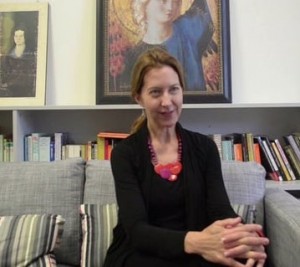 Sarah McNamer is Associate Professor of English and Medieval Studies at Georgetown University. Her primary interest is in the relation between literature and the history of emotion. Her book, Affective Meditation and the Invention of Medieval Compassion, published in 2010, looked at how devotional practices use ‘affective scripts’ to help readers cultivate emotional states. She is working on a book called The Poetics of Emotion in Middle English Literature, which explores the use of affective scripts in secular medieval poetry like the Pearl poem. Sarah recently came to our Centre to give the History of Emotions Annual Lecture for 2015, on the place of literary studies in the history of emotion. She has an article, “The Literariness of Literature and the History of Emotion”, forthcoming in PMLA October 2015.
Sarah McNamer is Associate Professor of English and Medieval Studies at Georgetown University. Her primary interest is in the relation between literature and the history of emotion. Her book, Affective Meditation and the Invention of Medieval Compassion, published in 2010, looked at how devotional practices use ‘affective scripts’ to help readers cultivate emotional states. She is working on a book called The Poetics of Emotion in Middle English Literature, which explores the use of affective scripts in secular medieval poetry like the Pearl poem. Sarah recently came to our Centre to give the History of Emotions Annual Lecture for 2015, on the place of literary studies in the history of emotion. She has an article, “The Literariness of Literature and the History of Emotion”, forthcoming in PMLA October 2015.
In your lecture, you argued that the Pearl poem is a sort of guided therapeutic meditation.
Yes, it is a sensual and affective experience designed to take the listener from ‘woe’ to ‘weal’, in the context of grief for a young child.
Guided therapies are usually repeated, so that the balm sinks in, as it were. Was that the case with this poem?
Yes, it does seem that the musical qualities of the poem are designed to be therapeutic, to be soothing, to draw the reader back in to the poem over and over again. Barbara Newman, in her wonderful article ‘The Artifice of Eternity’, says the Pearl poem is ‘the most intricate in the English language’. And she’s right. The poem is perpetually admired because of its beauty, its highly-wrought quality. It has a virtuosic triplicate rhyme scheme, with alliterative rhyme, with end-rhyme and with concatenation. It’s a kind of verbal music, related to what the French poets called musique naturelle, produced by the sound of the spoken voice alone. So listening to the poem again and again would have been a soothing experience, related to a medieval poetics of ‘sweetness’ , a kind of persuasiveness through the sound of the poem.
I think of consolation scripts in ancient philosophy, like Seneca’s Consolation to Marcia for example. They were on the whole quite rational and cognitive. But you suggest that part of the therapeutic power of Pearl is not just cognitive, it’s something deeper and less rational.
Right. In the opening canto, the father comes up against the limit of reason and faith. At the end of the very first canto, he’s struggling to understand his situation in terms of reason and faith, and he simply cannot. The poet figures that forth by having him faint on the grave of his child. And then he wakes into this gorgeous dream vision. The dream vision enables the poet to take us into another space, which is about the senses and the emotions , and it’s not fully rational. It’s a space where the affective and the cognitive can come together in a dream vision, which is a literary invention.
Do you think that there’s something poetry can do that normal prose can’t in terms of its therapeutic or persuasive power over us?
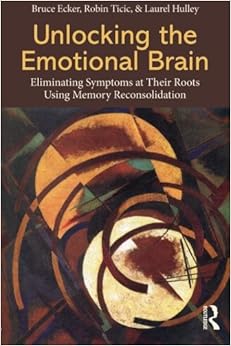 That would be a challenging question to answer, but I have looked into some grief therapies, and was struck by one set of discussions having to do with metaphor. The metaphors that people grasp onto when they’re grieving can be very helpful for them. There’s also something in contemporary therapeutic practice called the ‘juxtaposition experience’, which unlocks the emotional brain (this is described in Bruce Ecker’s book Unlocking the Emotional Brain). This poem seems to be offering an experience of art which juxtaposes loss with something vibrant, beautiful and healing.
That would be a challenging question to answer, but I have looked into some grief therapies, and was struck by one set of discussions having to do with metaphor. The metaphors that people grasp onto when they’re grieving can be very helpful for them. There’s also something in contemporary therapeutic practice called the ‘juxtaposition experience’, which unlocks the emotional brain (this is described in Bruce Ecker’s book Unlocking the Emotional Brain). This poem seems to be offering an experience of art which juxtaposes loss with something vibrant, beautiful and healing.
You explored the notion of ‘addubement’ in the Pearl poem, which can be translated as embellishment. There’s an idea that something man-made and artificial – a beautiful intricately-constructed poem – can be therapeutic in the face of bereavement. How does that work?
The poet is striving to do what verbal art can do, which is enliven a space of imaginative play, colour and light. The embellishment that the poet comes back to again and again is signifiying a kind of recognition of the poet’s power to generate in the brain of the reader a display of glittering luminosity. It seems that the poet is placing a lot of emphasis on that as a way of moving beyond grief – the experience of an imagined display of colour and light can move one to an affective space that is positive and beneficial.
So it’s an assertion of the healing power of art as opposed to the Holy Spirit?
Absolutely. It seems that this poet is seeking to mark that difference. The poem keeps coming back to the actual crafting that human artists can do which effects healing.
You suggest that the poem was written specifically for the context of the court of Edward III, whose son lost a young daughter. If I was that son, I’d want to know – is this just a story, is this just an imagined space, or is my daughter really in heaven? That would matter to me.
The story in the poem is a story but it also has belief behind it – the Christian belief in the afterlife is very powerful there. But there is also a layer of the story which is pre-Christian or more than Christian, a desire to know where that child is, a desire to ‘place’ her in a safe and happy elsewhere that can be vividly imagined and experienced as consoling, even if not ‘true’.
There was a debate, wasn’t there, about medieval visualisation meditations on the Passion – some critics felt meditation books encouraged people to embellish, to add their own details to the Passion in a way that was un-Biblical and potentially heretical. How conventional or Biblical is the Pearl poet’s vision of heaven?
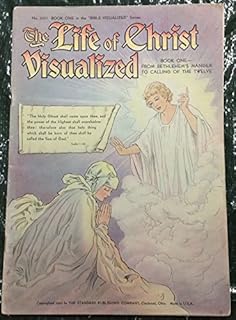 Well, just to take up the issue of imaginative visualisation meditations, one of the texts that I’ve worked most on is the Meditations on the Life of Christ by an anonymous author usually called Pseudo-Bonaventure. Historically, that text set a template and authority for imaginative practices. It tells people to imagine these scenes from the life of Christ with all the embellishments that you want to add, and ‘give authority to the imagination’. So this devotional text is very assertively saying that the imagination has authority.
Well, just to take up the issue of imaginative visualisation meditations, one of the texts that I’ve worked most on is the Meditations on the Life of Christ by an anonymous author usually called Pseudo-Bonaventure. Historically, that text set a template and authority for imaginative practices. It tells people to imagine these scenes from the life of Christ with all the embellishments that you want to add, and ‘give authority to the imagination’. So this devotional text is very assertively saying that the imagination has authority.
The Pearl‘s afterlife is modelled on known images of the afterlife. It’s a very elaborate and beautiful scene that comes partly from Revelations but contains many of the poet’s own embellishments, including this lovely, touching scene of the child depicted as ‘my little queen’ playing with her friends. She’s in motion, in movement, with this ‘jolly pack’ of friends.
The idea of the ‘authority of the imagination’ in the 14th century – was that a new and controversial idea?
It wasn’t a new idea. If we look back at the tradition of affective meditation, the setting of the scene, the invitation to situate yourself there at the foot of the cross for example, is present much earlier. Because of the affective usefulness of imaginative practices, it became a very widespread notion.
Did people ever criticise such practices?
There certainly is critique. One place I’ve noticed this is various early adaptations of the Meditations on the Life of Christ. I discovered a short Italian version of the Meditations which I think is the original version, which was then added to while some parts of it were suppressed. And in that movement between different versions of the text one can see critique. There is a worry about whether imaginative practices were leading people to overly humanise Christ. There’s an effort in later versions of the text to curtail imaginative practices that dwell too much on the vulnerability of Christ.
These affective scripts aimed to create emotional effects, but did they ever have more powerful impacts, where they actually shaped people’s visionary experiences?
Yes, absolutely. One can see that in very many instances, for example Julian of Norwich, and Margary Kempe, and others.
So you’re looking at affective scripts in contemplative texts, and now also in secular poetry. What is the relationship between those two traditions in the Middle Ages?
It’s a good question, and one I have only begun to answer. I think the secular texts were influenced by the devotional texts. Devotional texts and ways of reading were so widespread that they provided a very robust template for what other literature might do.
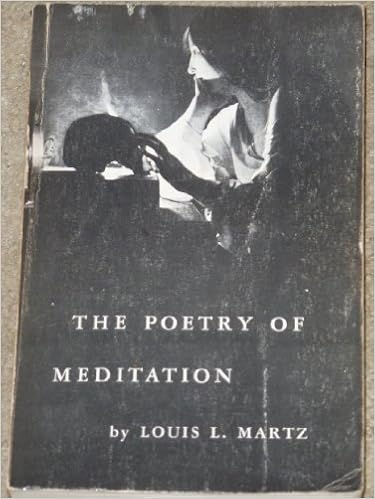 Louis Martz’ Poetry and Meditation argues that secular poetry starts to do things that contemplative poetry used to do in the 16th and 17th centuries, and almost that secular poetry becomes an alternative contemplative practice for lay people. You’re saying that process began much earlier, at least as far back as the 14th century?
Louis Martz’ Poetry and Meditation argues that secular poetry starts to do things that contemplative poetry used to do in the 16th and 17th centuries, and almost that secular poetry becomes an alternative contemplative practice for lay people. You’re saying that process began much earlier, at least as far back as the 14th century?
It seems to have. It’s under-explored at this point.
To what extent did medieval contemplative texts use poetry?
Most of the early vernacular affective meditations are lyrics. They’re easy to memorise, they’re short, they’re rhythmic. For example, the lyric Sunset on Calvary, it’s just four lines:
Now goes the sun under the wood –
Pity, Mary, thy fair face.
Now goes the sun under the tree –
Pity, Mary, thy son and thee.
This lyric immediately places its reader at the foot of the cross as a feeling participant. In the original Middle English, the lines rhyme, and would have been easy to internalize.
You talked about the musicality of Pearl. Would some of these affective scripts ever have been sung?
Some of the lyrics certainly would have been. In the 13th and 14th century, some of the lyrics have accompanying notation.
I guess a type of affective script that becomes very key is hymn-singing, or indeed psalm-singing – they guide our emotions together through music and lyrics.
Indeed.
What are the key differences between affective scripts in religious and secular contexts? You suggest secular poetic scripts are more playful, more ambiguous, more ‘polyvalent’, and perhaps more inclined to draw our attention to the skill of the craftsman?
I think we see that with the Pearl poet. He’s an interesting figure – resolutely anonymous, but brilliantly crafting something that brings all poetic skills to bear on the listening experience. Perhaps the freedom of writing outside the devotional realm enabled that. In devotional texts, there’s often more pressure to avoid overly ornamental flourishes.

‘Don Quixote reading novels of chivalry’ by Gustave Dore
This idea of literary texts as affective scripts – where else could one apply it? For example, romantic love poetry like Ovid’s Art of Love could be a type of affective script, teaching us how to love.
Right. And to take the example of Eloise, her mind was so well-stocked with poetry and impassioned rhetoric….
Or Madame Bovary….
…you can see how real feeling is fostered and nourished by having poetry in the mind.
And I suppose the novel then creates figures whose emotions have been nourished by romance and fable, then coming into comic or tragic dissonance with a more prosaic world. That’s what happens in Don Quixote, or Madame Bovary.
Yes, Jane Austen’s Northanger Abbey explores similar terrain. But in the Middle Ages there’s a very different attitude about the relationship between artifice and reality. There isn’t a dichotomy between artificial and real feelings. Artifice is valued as a way of generating real feeling.
And there’s less of a distinction between inner imaginative worlds and outer reality too.
Yes.
Sometimes, texts are not written consciously as affective scripts for others to follow, but they become them. They get taken up. For example, Goethe’s Sorrows of Young Werther, or Rousseau’s Nouvelle Heloise. Or even, say, Stanley Kubrick’s Clockwork Orange then becomes a violent script that some young people choose to follow. Your research focuses on intentionally-crafted scripts for others, but sometimes this happens non-intentionally.
Yes, that probably does happen. For example, in Chaucer’s Troilus and Criseyde, you see that Troilus thinks that he might be tragic lover, and her refers to tragic lovers of the past, and then he becomes a tragic lover. He has to, according to the script fixed in his mind.
There’s also the question of how ancient affective scripts affect people today, and how people can use them today. Can we still use medieval contemplative texts today?
I’m not sure. They’re historically bound in many ways. It’s an open question.
T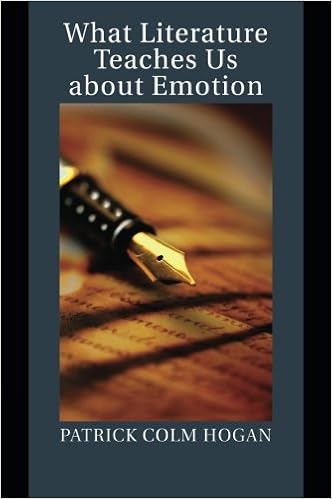 o what extent is there an ‘affective turn’ in literary studies?
o what extent is there an ‘affective turn’ in literary studies?
That was named eight or ten years ago, and it certainly is happening across various forms of literary criticism. I think of the work that’s been done on the novel and empathy by Susan Keen, or Patrick Colm Hogan’s work on literature and emotions. There’s a much more rigorous assessment of how literary texts produce emotions, but that work hasn’t been situated historically that much. I’m seeking to root particular texts in particular historical circumstances, to ask how literary devices embedded in a certain genre seem to seek to produce emotion in a given historical context.
How do you situate your work relative to the history of emotions?
That’s one thing I explored in my talk yesterday. There is a way that the history of emotions has a double structure. One meaning of the ‘history of emotions’ is a very encompassing one that has a kind of capaciousness within it, that sees literary studies as part of an effort to engage with the emotions of the past. But there is also a narrower meaning of the term ‘history of emotions’ which really does function as a sub-discipline within the discipline of history. Literature is not very visible at all in publications within that narrower definition. That’s one opposition that I’m working to overcome.
Does the study of emotion naturally tends towards or even requires inter-disciplinarity? I think of Martha Nussbaum’s work on the philosophy of emotions, which also brings in political science, psychology, literary studies, music studies, architecture, urban planning and economics!
I think that’s absolutely the case.
